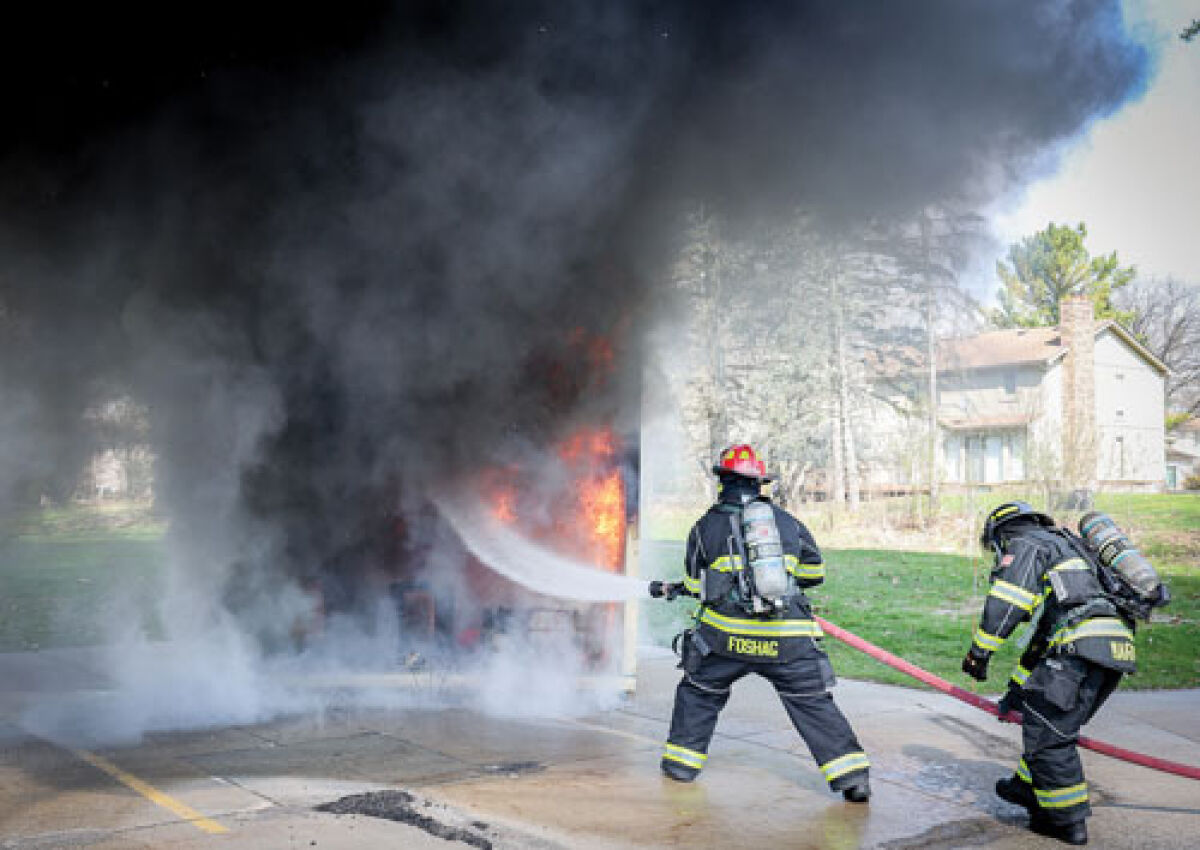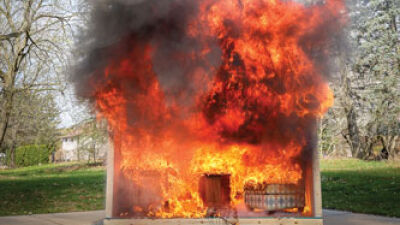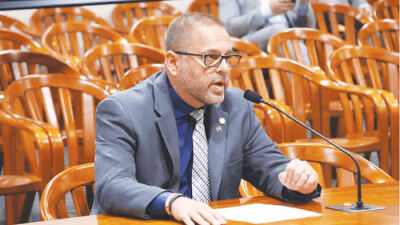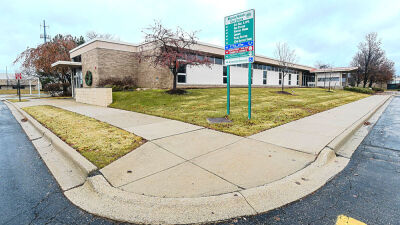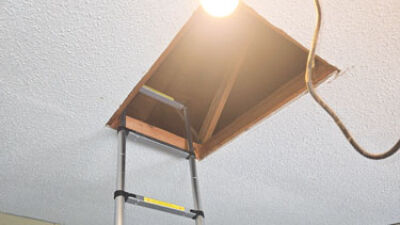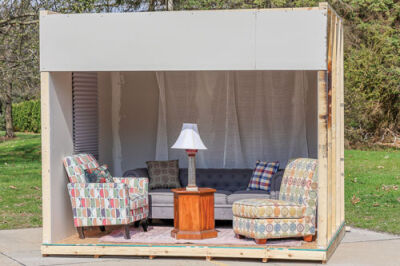
A calm-looking living room can turn into a raging fire in a matter of seconds, as demonstrated at Farmington Hills Fire Department Station #4 April 23. Smoke alarms can alert those inside before they smell smoke or see flames.
Photo by Patricia O’Blenes
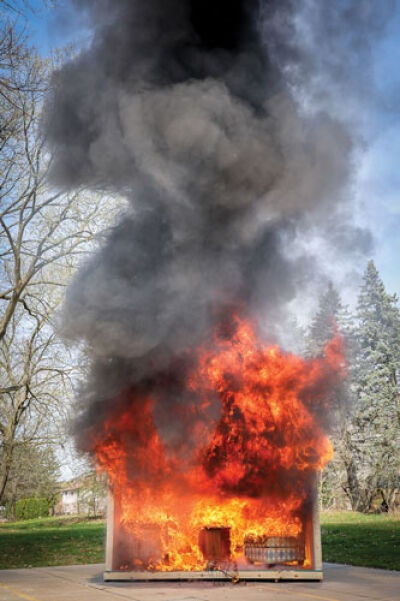
In only one minute and 40 seconds flames engulfed a room during a controlled-room fire demonstration April 23 at Farmington Hills Fire Department Station #4. “Fires today are burning hotter and faster than they ever have,” said Farmington Hills Fire Department Lt. Brian Pankow.
Photo by Patricia O’Blenes
FARMINGTON HILLS — Having working smoke alarms in the home was the key message when the Farmington Hills Fire Department and the American Red Cross teamed up to promote home fire safety at a live controlled-room fire demonstration April 23.
The demonstration took place at the Farmington Hills Fire Department Station #4, located at 28711 Drake Road.
A living room was built in a structure approximately 10 feet by 10 feet that included the type of furnishings that can be found in many living rooms — an upholstered sofa, two upholstered chairs, tables, lamps, and drapes. A trained firefighter in full gear ignited the drapes. Just seconds afterwards, when only a small flame was visible, the smoke alarm sounded.
It was just a matter of seconds before the room was engulfed in flames and black plumes of smoke filled the area. Those watching stepped back.
“One minute and 40 seconds is all it took,” said Farmington Hills Fire Department Lt. Brian Pankow, who is also the city’s emergency manager.
That amount of time encompasses the start of the fire to when the room was totally engulfed in flames.
According to the Farmington Hills Fire Department and the American Red Cross, a working smoke alarm reduces the risk of being injured or dying in a fire in half.
Fires can start off very small, according to Pankow. It can be a spark from an outlet, a flame from a burning candle, or a space heater next to a flammable object.
According to Pankow, these demonstrations are not to scare people, but rather to prepare them.
“Fires today are burning hotter and faster than they ever have,” Pankow said. “This is due to the synthetic materials that go into your furnishings. They’re in your laminate floors, hardwood floors, couches, (and) they’re even in our clothes.”
Having an escape plan is also an important part of being prepared.
“We want to make sure you understand how important it is to make quick and smart choices, react appropriately, and get out and stay out.” Pankow said.
The lieutenant shared multiple fire safety tips, including having working smoke alarms and carbon monoxide — or CO — alarms.
The smoke detectors should be installed on every floor and in every bedroom and tested monthly to make sure they are working properly.
Individuals using a 9-volt, battery-operated smoke alarm should test it twice a month and change the battery every six months.
The Fire Department recommends using 10-year, lithium-ion battery-operated smoke alarms and CO alarms. At the end of the life cycle, the alarms should be replaced.
Although the event focused on smoke alarms, Pankow addressed the concerns of carbon monoxide.
“It is known as the silent killer. It is odorless, colorless, (and) it is very, very deadly,” he said. “Close before you doze”.
In the event of a fire starting while sleeping, closing the door slows the heat and smoke from getting into the bedroom. This gives “extra precious minutes” to get out of the home, according to Pankow.
In the event of a fire, residents are advised to get out and stay out of a burning home, not grab anything on the way out, and to not go back in.
Given that homeowners may not smell smoke while they are sleeping or when in a different room from the smoke, Pankow shared a potentially life-saving advantage of having working alarms.
“These alarms are working 24 hours a day, 365 for you,” Pankow said.
A family escape plan should be practiced at least twice a year, with occupants knowing two ways out of a room, one of which may include a window.
Escape plans should be practiced in the morning and at night and include pets. Having a designated meeting area should also be part of the plan.
Preparation plans should also include teaching children to call 911 and making sure that they know their home address.
Farmington Hills residents that do not have a smoke alarm can contact the Farmington Hills Fire Department Prevention Division at (248) 871-2800.
The American Red Cross responds to house fires every day, according to Latoysa Rooks, who is a regional disaster officer for the Red Cross.
So far this year the Red Cross has responded to nearly 550 fires and provided services to 2,000 individuals, with services including emergency sheltering and disaster health services, according to Rooks.
“We are able to do this because of the kind donations of others,” Rooks said.
The Red Cross installs traditional smoke alarms that emit a high-pitch sound, as well as those with flashing lights for the hearing impaired. The alarms are provided and installed at no charge.
The mission of the Red Cross is to alleviate human suffering in the face of emergencies, according to Carnel Richardson, who is a disaster program manager for the American Red Cross of Southeast Michigan.
“When you see a Red Cross vehicle in your community, you can take comfort in knowing that we are here to be a beacon of hope and to be the best thing that happens to someone on the worst day of their life,” Richardson said.
For smoke alarms or assistance after a fire or other disasters, call the Red Cross at 1-800-Red Cross.
 Publication select ▼
Publication select ▼